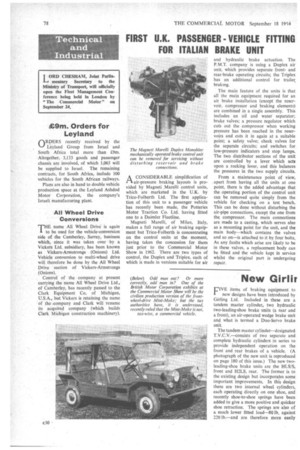FIRST U.K. PASSENGER VEHICLE FITTING FOR ITALIAN BRAKE UNIT
Page 80

Page 81

If you've noticed an error in this article please click here to report it so we can fix it.
1Iew Water-flow System for Bedford 330 Cu. in.
Diesel Improves Gas Sealing
A CONSIDERABLE simplification of 1-i air-pressure braking layouts is provided by Magneti ,Marelli control units, which are marketed in the U.K. by Trico-Folberth Ltd. The first application of this unit to a passenger vehicle has recently been made, the Potteries Motor Traction Co. Ltd. having fitted one to a Daimler Fleetline.
Magneti Marelli, of Milan. Italy, makes a full range of air braking equipment but Trico-Folberth is concentrating on the control units at the moment, having taken the concession for them just prior to the Commercial Motor Show in 1962. There are two types of control, the Duplex and Triplex, each of which is made in versions suitable for air
and hydraulic brake actuation. The P.M.T. company is using a Duplex air unit, which provides separate frontand rear-brake operating circuits; the Triplex has an additional control for trailer braking.
The main feature of the units is that all the main equipment required for an air brake installation (except the reservoir, compressor and braking elements) are combined in a single assembly. This includes an oil and water. separator; brake valves; a pressure regulator which cuts out the compressor when working pressure has been reached in the reservoirs and cuts it in again at a suitable point; a safety valve; check valves for the separate circuits; and switches for low-pressure indicators and stop lamps. The two distributor sections of the unit are controlled by a lever which acts upon a rocking lever, and this balances the pressures in the two supply circuits.
From a Maintenance point of view, apart from having all the units at one point, there is the added advantage that the operating portion of the control unit can be removed quite simply from the vehicle for checking on a test bench. This can be done without disturbing the air-pipe connections, except the one from the compressor. The main connections are made to a casting, which serves also as a mounting point for the unit, and the main body—which contains the valves and so on—is attached to it by four bolts. As any faults which arise are likely to be in these valves, a replacement body can be fitted and the vehicle kept in service whilst the original part is undergoing repair.
k NEW approach to gas sealing in 1 diesel engines announced by auxhall Motors Ltd. is achieved by an d-to-end water-flow system in the finder block and head. The large tmber of water passages between the ,o components are eliminated, the only iter connection between the head and ock being at the rear on extensions Dm the castings.
This system is now standard on the :dford 330 cu. in. six-cylinder diesel and well as making possible improved gas sealing it is said that the engine cooling is more efficient and that warm-up is quicker and more uniform, particularly in the case of the rearmost cylinders. As there are no water passages between the block and head faces, the head gasket is called upon to perform only one function and can therefore be specifically designed for this purpose—preventing the escape of gases. The sole water connections between the head and block are at the rear of the engine, beyond the gasket, and here there are two relatively large diameter connecting holes which are sealed separately by rubber components.
It is claimed that gasket life will be increased considerably and that another major achantage is extra rigidity of the cylinder head, reducing any tendency to warping. The head and block faces are completely unbroken except for the bore and stud apertures and because of this more uniform holding-down pressures can be obtained over the whole area and all sealing pressures imposed evenly on the eyelets around the holes in the gasket.


































































































































































































































































